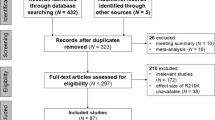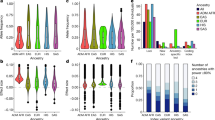Abstract
Mounting evidence suggests that hypertension is strongly linked to a variety of lipoprotein metabolism abnormalities. Apolipoprotein E gene (ApoE) is one such candidate with its common ɛ2/ɛ3/ɛ4 polymorphism ranking high in hypertension association. To derive more specific information, we pinpoint our research scope in Chinese to test whether this polymorphism is associated with hypertension via a meta-analysis. Random-effects model was performed irrespective of the between study heterogeneity. Data and study quality were assessed in duplicate. Publication bias was evaluated using the fail-safe number. Overall, 12 studies with 14 study groups totalling 1532 hypertensive patients and 2172 controls were identified. Carriers of ApoE ɛ2 allele had no significant increased risk for hypertension (pooled odds ratio (OR)=1.04; 95% confidence interval (CI): 0.80–1.35; P=0.78), compared with those carrying ɛ3 allele, whereas those with ɛ4 allele had a significant increased risk for hypertension (pooled OR=2.03; 95% CI: 1.61–2.55; P<0.00001). After excluding those with other small nationalities, we observed comparison of ApoE ɛ2 with ɛ3 allele yielded a pooled OR of 0.99 (95% CI: 0.82–1.19; P=0.89) among Han Chinese, and that of ɛ4 with ɛ3 yielded a pooled OR of 1.99 (95% CI: 1.48–2.67; P<0.00001). The fail-safe number at the level of 0.05 supported these significant associations. Taken together, our results expand previous findings and show that ApoE ɛ4 allele is associated with a twofold increased risk of developing hypertension in Chinese.
This is a preview of subscription content, access via your institution
Access options
Subscribe to this journal
Receive 12 digital issues and online access to articles
$119.00 per year
only $9.92 per issue
Buy this article
- Purchase on Springer Link
- Instant access to full article PDF
Prices may be subject to local taxes which are calculated during checkout




Similar content being viewed by others
References
Wu Y, Huxley R, Li L, Ogaoawara AK, Dybdal N, Bunting S et al. Prevalence, awareness, treatment, and control of hypertension in China: data from the China National Nutrition and Health Survey 2002. Circulation 2008; 118: 2679–2686.
Yang J, Lu F, Zhang C, Liu Z, Zhao Y, Gao F et al. Prevalence of prehypertension and hypertension in a Chinese rural area from 1991 to 2007. Hypertens Res 2010; 33: 331–337.
Izawa H, Yamada Y, Okada T, Tanaka M, Hirayama H, Yokota M . Prediction of genetic risk for hypertension. Hypertension 2003; 41: 1035–1040.
Niu W, Guo X, Su Y, Qiu C . Apolipoprotein E and low-density lipoprotein receptor gene polymorphisms in dyslipidemias-associated essential hypertension. J Hum Hypertens 2007; 21: 337–339.
Brewer Jr HB, Zech LA, Gregg RE, Schwartz D, Schaefer EJ . NIH conference. Type III hyperlipoproteinemia: diagnosis, molecular defects, pathology, and treatment. Ann Intern Med 1983; 98: 623–640.
Yang R, Powell-Braxton L, Ogaoawara AK, Dybdal N, Bunting S, Ohneda O et al. Hypertension and endothelial dysfunction in apolipoprotein E knockout mice. Arterioscler Thromb Vasc Biol 1999; 19: 2762–2768.
Niu W, Qi Y, Qian Y, Gao P, Zhu D . The relationship between apolipoprotein E epsilon2/epsilon3/epsilon4 polymorphisms and hypertension: a meta-analysis of six studies comprising 1812 cases and 1762 controls. Hypertens Res 2009; 32: 1060–1066.
Higgins JP, Thompson SG, Deeks JJ, Altman DG . Measuring inconsistency in meta-analyses. BMJ 2003; 327: 557–560.
Cohn LD, Becker BJ . How meta-analysis increases statistical power. Psychol Methods 2003; 8: 243–253.
Borenstein M, Hedges LV, Higgins JPT, Rothstein HR . Introduction to Meta-Analysis 2009. John Wiley & Sons, Ltd: Chichester, UK.
Hamulati W, Aisikaer Y, Yilihamujiang S . Relationship between ApoE gene polymorphism and patients of hypertension in Uighur. Chin J Immunol 2003; 19: 108–110.
Zhimian Z, Haiqing G, Qing S, Lihua F . Clinical study of relationship between ApoE gene polymorphism and hypertension in aged. Acta Academiae Medicinae Shandong 2000; 38: 173–176.
Caiyou H, Chenguang Z, Zeping L, Ze Y, Jiying L, Yong W et al. The study of relation between blood pressure and apolipoprotein E genotypes in long-lived elderly in Bama area of Guangxi. Chin J Geriatr Heart Brain Vessel Dis 2007; 9: 11–13.
Weize Z, Xinghui L, Yongqing C, Ling M, Mingxu Z, Mian Q et al. Relationship between apolipoprotein E gene polymorphism and essential hypertension in Han, Tibetan and Hui population in high altitude area. Chin Circ J 2007; 22: 263–266.
Chunli R, Yingxin P, Meixia L, Ruyi L, Xue G . Analysis of apolipoprotein E gene polymorphism in hypertensive patients. Shandong Med J 2007; 47: 29–30.
Yingwang L, Shuiping Z, An Z, Sai N . Effect of apolipoprotein E gene polymorphism on lipid and essential hypertension. Chin J Arterioscler 2002; 10: 517–520.
Wen P, Siming G, Wei L, Xiaohong Z . Apolipoprotein E gene polymorphism and hypertension. J Chin Gen Pract 2003; 2: 14–15.
Guofang C, Zhu M, Bingxian H . Relationships between polymorphism of apoE gene and hypertension in the Han ethnics of China. Chin J Clin Rehab 2003; 7: 2545–2546.
Min P, Jianhua Z, Li L, Haiyan P, Huimin W, Shu L et al. Association of Apolipoprotein E with essential hypertension, NIDDM and coronary heart disease in Chinese population. Chin Synth Med 2002; 3: 1–3.
Li X, Du Y, Du Y, Huang X . Association of apolipoprotein E gene polymorphism with essential hypertension and its complications. Clin Exp Med 2003; 2: 175–179.
Ruixing Y, Jinzhen W, Weixiong L, Yuming C, Dezhai Y, Shangling P . The environmental and genetic evidence for the association of hyperlipidemia and hypertension. J Hypertens 2009; 27: 251–258.
Kesäniemi YA, Ehnholm C, Miettinen TA . Intestinal cholesterol absorption efficiency in man is related to apoprotein E phenotype. J Clin Invest 1987; 80: 578–581.
Cardon LR, Bell JI . Association study designs for complex diseases. Nat Rev Genet 2001; 2: 91–99.
Munafò MR, Flint J . Meta-analysis of genetic association studies. Trends Genet 2004; 20: 439–444.
Utermann G, Hees M, Steinmetz A . Polymorphism of apolipoprotein E and occurrence of dysbetalipoproteinaemia in man. Nature 1977; 269: 604–607.
Peacock ML, Fink JK . ApoE epsilon 4 allelic association with Alzheimer's disease: independent confirmation using denaturing gradient gel electrophoresis. Neurology 1994; 44: 339–341.
Pang CP, Baum L, Chan WM, Lau TC, Poon PM, Lam DS . The apolipoprotein E epsilon4 allele is unlikely to be a major risk factor of age-related macular degeneration in Chinese. Ophthalmologica 2000; 214: 289–291.
Woo D, Kaushal R, Chakraborty R, Woo J, Haverbusch M, Sekar P et al. Association of apolipoprotein E4 and haplotypes of the apolipoprotein E gene with lobar intracerebral hemorrhage. Stroke 2005; 36: 1874–1879.
Acknowledgements
This work was supported by the Shanghai ‘Chen Guang’ Project (09CG12), the Natural Science Foundation of Shanghai (09ZR1426200) and the National Science Foundation for Young Scientists of China (Grant Number: 30900808).
Author information
Authors and Affiliations
Corresponding author
Ethics declarations
Competing interests
The authors declared no conflict of interest.
Additional information
Supplementary Information accompanies the paper on the Journal of Human Hypertension website
Supplementary information
Rights and permissions
About this article
Cite this article
Niu, WQ., Qi, Y. Meta-based evidence for apolipoprotein E ɛ2/ɛ3/ɛ4 polymorphism in association with hypertension among Chinese. J Hum Hypertens 25, 725–731 (2011). https://doi.org/10.1038/jhh.2010.116
Received:
Revised:
Accepted:
Published:
Issue Date:
DOI: https://doi.org/10.1038/jhh.2010.116
Keywords
This article is cited by
-
Association between eNOS rs1799983 polymorphism and hypertension: a meta-analysis involving 14,185 cases and 13,407 controls
BMC Cardiovascular Disorders (2021)
-
Age-related trends of blood pressure levels by apolipoprotein E genotype: the Bambuì cohort study of ageing (1997–2008)
Hypertension Research (2013)
-
The association between apolipoprotein E gene polymorphisms and essential hypertension: a meta-analysis of 45 studies including 13 940 cases and 16 364 controls
Journal of Human Hypertension (2013)
-
Association of an apolipoprotein E polymorphism with circulating cholesterols and hypertension: a meta-based Mendelian randomization analysis
Hypertension Research (2012)
-
ApoE gene polymorphism and vascular dementia in Chinese population: a meta-analysis
Journal of Neural Transmission (2012)



